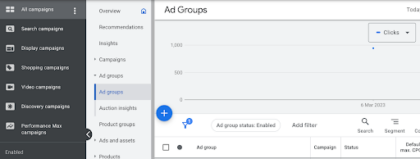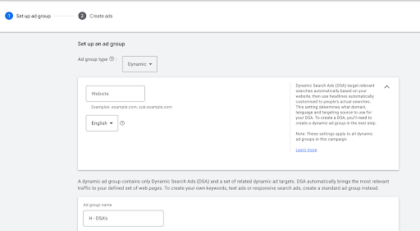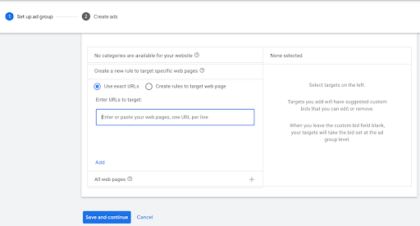In today’s digital age, businesses are always looking for new ways to reach their target audience. Dynamic search ads (DSAs) have become a popular tool for marketers to expand their reach and increase conversions.
If you’re not familiar with DSAs, don’t worry! This guide will take you through everything you need to know about these ads, including what they are, what their benefits are, how they work, how to create them, and how to optimise them for maximum success. Let’s get started!
What are dynamic search ads?
Well-known in the world of paid media, dynamic search ads (DSA) allow advertisers to automatically create and target ads based on the content of their website.
Rather than having to manually create individual ads for your specific keywords, DSAs will do it for you using Google’s algorithm to scan the website and automatically create ad headlines.
Google dynamic search ad campaigns work by matching users’ search queries to the content on the advertiser’s website and then generating an ad that includes a headline and landing page based on that content.
As DSA campaigns will automatically generate ads that are relevant to each search, advertisers don’t have to worry about creating ads for every possible keyword or search query.
Benefits of dynamic search ads
There are many advantages of using dynamic search ads, including:
- Time saving: DSAs can save a huge amount of time compared to their manual counterparts. All you need to provide is a list of landing pages and let Google’s artificial intelligence do the hard work.
- Greater coverage: as you’re supplying a list of URLs to be scanned, you’re able to cover a much greater range of potential keywords or products that feature on the provided landing pages to match to a user’s search term.
- Cost saving: with quality scores forming the basis of how cost-per-click (CPC) is calculated, by improving your ad relevance, you’ll boost quality scores and gain a discount on your CPC, reducing your overall costs.
- Improved click through rate (CTR): another bonus of improved relevance is the impact it will have on your CTR. Users are much more likely to click on an advert when the headline is relevant to what they’ve searched for.
- Keyword scoping: DSAs are a great way to find new keywords that you should be specifically targeting and allocating a dedicated budget to. Check out the search term report of your DSA campaigns and look for top performing queries that you could break out into separate campaigns.
Disadvantages of dynamic search ads
While DSAs can be a useful tool for expanding your reach and driving conversions, there are some potential disadvantages to keep in mind:
- Lack of control: since DSAs rely on Google’s algorithm to determine which pages to target, you may not have as much control over where your ads appear or which search queries trigger them.
- Competition: depending on your industry, there may be a lot of competition for the same search queries, which can drive up the cost of your DSAs and make it harder to stand out.
- Ad relevance: DSAs rely on Google’s ability to scan your website and match your ads to relevant pages. If your website is not well-organised or has a lot of duplicate content, your DSAs may not be as relevant as you’d like.
- Limited ad formats: DSAs only allow for text ads, which may not be as eye-catching or engaging as other ad formats like display or video ads.
- Ad fatigue: if you’re not regularly updating your website or adding new content, your DSAs may start to feel repetitive or stale to users over time.
Overall, it’s important to weigh the advantages and disadvantages of DSAs and determine if they’re the right fit for your business goals and budget.
Dynamic ads best practices
When you’re running DSAs, you’re handing over control of a very important aspect of your activity: the ad copy and keyword targeting.
If you’re handing over that control, it’s crucial that you ensure the robots aren’t going totally rogue with your budget. Here are three top tips to ensure that the budget is being spent effectively.
1. Monitor and refine negative keyword lists
Even though DSA campaigns generate ads based on the content of the website, it’s still important to monitor and refine negative keyword lists to ensure that ads are not shown for irrelevant or low-intent search queries.
Make sure to continuously analyse the search terms report and add negative keywords that are not relevant to your business, or that lead to low click-through/conversion rates or high cost-per-acquisitions (CPAs).
2. Use ad groups and page feeds
To ensure that dynamic search ad campaigns are targeting the most relevant pages on the website, it’s important to create ad groups that are focused on specific themes or product categories.
This can be achieved by using page feeds, which allow advertisers to specify the URLs that should be included in each ad group.
3. Set bid adjustments based on performance
Like other types of search ads, it’s important to set bid adjustments based on performance to ensure ads are being shown to the right audience at the right time.
Analyse the performance of different ad groups and adjust bids based on factors such as location, time of day, and device type to improve overall campaign performance.
If you’re using automated bidding instead of bid adjustments, focus on your CPA or ROAS target.
How to create dynamic search ads
To kick things off, head to your search campaign of choice and hit the blue + button to create a new ad group. From the dropdown menu in the top left, switch from “standard” to “dynamic”.
 Use ad groups to segment your URLs, entering specific URLs in each ad group. It’s a good idea to group your URLs together based on a specific theme or product category/grouping.
Use ad groups to segment your URLs, entering specific URLs in each ad group. It’s a good idea to group your URLs together based on a specific theme or product category/grouping. Now you’ve done that, you’re ready to get started – just set your budget and bidding strategy and you can get activity live. Don’t forget to keep up with performance and use our tips above to get the most out of your newly launched DSA activity.
Now you’ve done that, you’re ready to get started – just set your budget and bidding strategy and you can get activity live. Don’t forget to keep up with performance and use our tips above to get the most out of your newly launched DSA activity.
Some commonly asked questions about DSAs
What targeting options are available for dynamic search ads?
DSAs offer several targeting options that can help you reach your desired audience. Here are some of the key ones:
- Landing pages: DSAs can target specific landing pages on your website. This allows you to showcase products or services related to those pages and increase the chances of driving conversions.
- Categories: you can target specific categories on your website, such as products, services, or blog posts. This can help you reach users who are interested in specific topics related to your business.
- Page feeds: Google Ads allows you to create a page feed that includes specific URLs, categories, or page titles. This feed can then be used to create highly targeted DSAs.
- All webpages: if you’re not sure which landing pages or categories to target, you can choose to target all webpages on your site. This can be a good option for businesses with a wide range of products or services.
- Demographics: you can also target specific demographics, such as age, gender, and location, to ensure your DSAs are reaching the right audience.
By leveraging these targeting options, you can create highly targeted DSAs that reach the right audience and drive conversions for your business.
How can I optimise my dynamic search ads?
There are a few ways you can optimise and improve your DSAs, including:
- Use negative keywords: just like with other types of search ads, negative keywords can help you exclude irrelevant search queries from triggering your DSAs. Review your search term report regularly to identify negative keywords and add them to your campaign.
- Optimise your website: since DSAs rely on your website content to match ads to relevant search queries, it’s important to keep your website up-to-date and well-organised. Make sure your landing pages have clear, relevant content and that your website structure is easy to navigate.
- Focus on high-performing categories/pages: use your analytics data to identify which categories and pages on your website are driving the most traffic and conversions. Focus your DSAs on these high-performing areas to maximise their impact.
- Use ad extensions: ad extensions can help you provide additional information to users and increase the visibility of your ads. Consider using extensions like sitelinks, callouts, and structured snippets to make your DSAs more informative and engaging.
- Test different ad copy: just like with other types of ads, testing different ad copy can help you identify what resonates best with your target audience. Try testing different headlines, descriptions, and calls-to-action to see what drives the most clicks and conversions.
- Monitor and adjust bids: keep a close eye on your DSAs’ performance and adjust your bids accordingly. Focus on bidding higher for high-performing categories and pages, and consider lowering bids for lower-performing areas.
- Leverage audience targeting: consider targeting specific audiences based on demographics or interests to ensure your DSAs are reaching the right people.
How can I track the performance of my DSAs?
There are a few ways to track your campaigns’ performance.
We recommend you set up conversion tracking in your Google Ads account to track the actions users take after clicking on your DSAs. This can help you identify which ads and landing pages are driving the most conversions.
Google Analytics is also a good tool to use if you have it set up. You can create custom reports and dashboards to see how your DSAs are performing and identify areas for improvement.
Don’t forget your search term reports too as this lets you see which search queries triggered your DSAs. From this data, you can then identify negative keywords and improve your targeting.
Monitor the performance of your DSAs’ headlines, descriptions, and landing pages to identify what’s working and what’s not. You can then use this information to test different ad copy and landing pages to improve your results.
Finally, if you’re using audience targeting with your DSAs, use the audience insights report in Google Ads to see how different audience segments are performing. Use this information to adjust your targeting and bidding strategies.
How often should I update my dynamic search ads?
The frequency at which you should update your dynamic search ads depends on several factors such as the size of your website, the frequency of changes to your website content, and the performance of your DSA campaigns.
However, as a general rule, it is a good practice to review and update your DSA campaigns regularly, at least once every month.
What types of businesses are best suited for dynamic search ads?
Dynamic search ads can be a good fit for businesses with large websites and a wide variety of products or services, including ecommerce, service-based, travel and tourism, educational institutions and even small, local businesses.
In general, any business with a website that frequently updates content, has a wide variety of products or services, or offers seasonal promotions can benefit from using DSA campaigns.
Final thoughts
Dynamic search ads are a powerful tool for businesses looking to increase their online presence and attract new customers as they allow you to automatically generate highly relevant ads based on the content of your website, making it easy to promote a large inventory of products or services.
With the ability to target specific search queries and adjust bids based on performance data, DSA campaigns can help you maximise your ROI and reach new audiences. Whether you run an ecommerce site, service-based business, travel agency, or local business, DSAs can help you achieve your advertising goals.
By regularly reviewing and updating your DSA campaigns, you can ensure that they remain relevant and effective in driving traffic and conversions to your website.
I hope you found this guide on dynamic search ads useful, but if you need a hand with your ad campaigns, get in touch with our paid advertising team who’ll be happy to help and talk you through the best process for your business.









